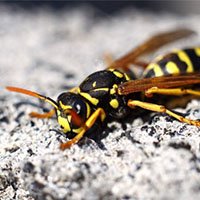
Ground Wasps: A Detailed Overview
Introduction
Ground wasps are fascinating insects that play significant roles in ecosystems and agriculture. Unlike their more notorious relatives, the yellow jackets and hornets, ground wasps are often overlooked and misunderstood. This article delves into the biology, behavior, and ecological importance of ground wasps, as well as the precautions one should take when encountering them.
Classification and Species
Ground wasps belong to the family Vespidae, which includes many social and solitary wasps. Within this family, several genera of ground-dwelling wasps can be identified, such as:
- Sphecius: Known as cicada killers, these wasps are large and solitary, targeting cicadas as their primary prey.
- Bembix: These wasps are sand-loving species that hunt various insects and are often found in sandy habitats.
- Ammophila: Commonly referred to as thread-waisted wasps, these are slender and typically prey on caterpillars.
Each species has unique characteristics and behaviors, but all share the common trait of nesting in the ground.
Habitat
Ground wasps can be found in diverse habitats, including:
- Sandy soils: Many ground wasps prefer to nest in loose, sandy soils, where they can easily dig tunnels.
- Grasslands: Open areas with sparse vegetation provide suitable conditions for foraging and nesting.
- Urban gardens: Ground wasps are often found in gardens and yards, particularly where their prey is abundant.
Nesting Behavior
Unlike social wasps, which build large communal nests, ground wasps are primarily solitary. They typically create small burrows in the ground, which serve as their nests. The nesting process involves:
- Digging a burrow: The female wasp excavates a tunnel in the ground, often several inches deep, which can branch into multiple chambers.
- Prey capture: After constructing the nest, the female hunts for prey, paralyzing it with her sting to provide food for her larvae.
- Egg-laying: Once the prey is secured, the female lays an egg on the paralyzed insect and seals the chamber, ensuring the larva has food when it hatches.
Diet
Ground wasps are predators, primarily feeding on other insects. Their diet varies based on species, but common prey includes:
- Cicadas: Cicada killers specifically target cicadas, paralyzing them to feed their young.
- Flies: Many ground wasps hunt flies, capturing them in mid-air.
- Caterpillars: Thread-waisted wasps often hunt caterpillars, which provide substantial nourishment for their larvae.
Life Cycle
The life cycle of ground wasps consists of four stages: egg, larva, pupa, and adult.
- Egg: The female lays her egg in a sealed chamber with a paralyzed prey item.
- Larva: Upon hatching, the larva feeds on the prey, growing rapidly.
- Pupa: After fully developing, the larva pupates within the nest, undergoing metamorphosis.
- Adult: The adult emerges from the pupal stage, ready to begin the cycle again.
The entire life cycle can take several weeks, depending on environmental conditions and species.
Ecological Importance
Ground wasps play a vital role in ecosystems:
- Pest control: As predators, they help control populations of various insects, including pests that may damage crops.
- Pollination: While not primary pollinators, some ground wasps contribute to pollination as they move between flowers in search of prey.
- Soil aeration: The nesting activities of ground wasps can help aerate the soil, promoting healthy plant growth.
Human Interaction
While ground wasps generally pose little threat to humans, their presence can lead to conflicts, especially when they nest near human activities. Here are some points to consider:
- Defensive behavior: Ground wasps will defend their nests aggressively if they feel threatened. It’s essential to be cautious around their nesting areas.
- Allergies: Some individuals may have allergic reactions to wasp stings, which can be severe in certain cases.
- Nesting management: If a nest is found in a problematic area, it is advisable to contact a pest control professional for safe removal rather than attempting to handle it personally.
Conclusion
Ground wasps are remarkable insects that contribute significantly to their ecosystems through predation and soil health. Understanding their behavior and ecological roles can help foster a greater appreciation for these often-misunderstood creatures. While they may pose some risk when nesting near human habitation, with proper awareness and precautions, humans can coexist peacefully with these beneficial insects.